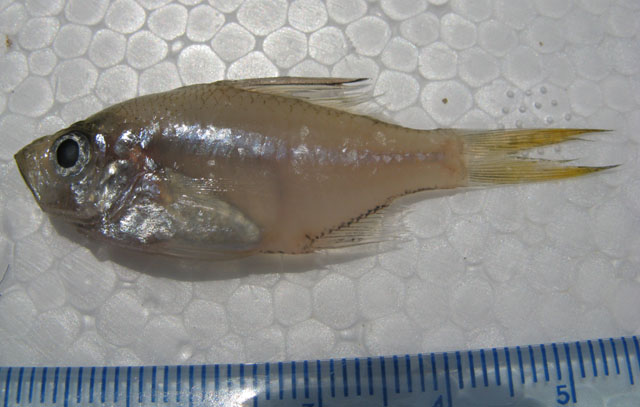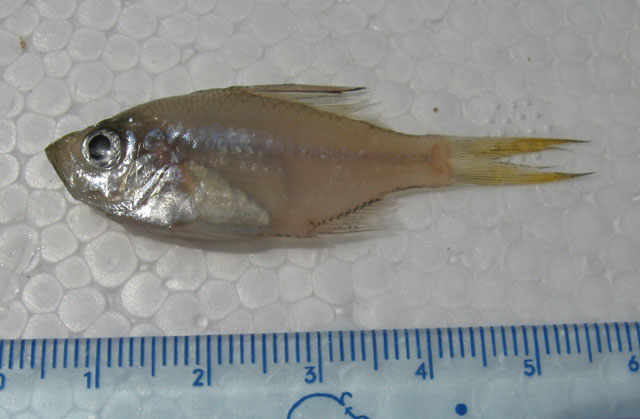Ambassis
interrupta
Bleeker,
1853
Long-spined glass perchlet
View all media / Upload your photos and videos
Expand all
Classification / Names
Teleostei (teleosts) > Ovalentaria/misc (Various families in series Ovalentaria) >
Ambassidae (Asiatic glassfishes)
Etymology: Ambassis: Derived from Greek, anabasis = climbing up (Ref. 45335).
More on author:
Bleeker.
Environment / milieu / depth range / climate zone / distribution range
Marine; brackish; freshwater; demersal; amphidromous (Ref. 59012); tropical; 19°N - 23°S -.
Distribution
Maps

Ambassis interrupta / Native range
AquaMaps Data sources:
GBIF
OBIS
This map was computer-generated and has not yet been reviewed.

Ambassis interrupta / Suitable habitat
AquaMaps Data sources:
GBIF
OBIS
This map was computer-generated and has not yet been reviewed.

Ambassis interrupta / Point map
AquaMaps Data sources:
GBIF
OBIS
This map was computer-generated and has not yet been reviewed.

Ambassis interrupta / Year 2050
AquaMaps Data sources:
GBIF
OBIS
This map was computer-generated and has not yet been reviewed.
Length at first maturity / Size / Weight / Age
Short description
Dorsal spines (total): 8; Dorsal soft rays (total): 9 - 10; Anal spines: 3; Anal soft rays: 9 - 10. Body very high, 50% of SL. Lateral line incomplete, but a few pored scales on a silvery midlateral band. Lower margin of inter operculum with few spines. The second spine of the first dorsal fin is strong and very long.
Biology
Found in brackish-water, mangrove, estuarine and freshwater-stream habitats, usually within 20 km of the sea (Ref. 2847). They occur at temperatures ranging from 28 to 32°C. Found in schools and migrate to freshwater. Mainly diurnal. A predominantly marine or estuarine spawner. Caught by hand and scoop nets (Ref. 7242).
Life cycle and mating behavior
A nonobligatory plant spawner.
Main reference
Allen, G.R. 1991 Field guide to the freshwater fishes of New Guinea. Publication, no. 9. 268 p. Christensen Research Institute, Madang, Papua New Guinea. (Ref. 2847)
IUCN Red List Status (Ref. 125652)
Least Concern (LC); date assessed: May 11 2020
CITES (Ref. 131153)
Not Evaluated
CMS (Ref. 116361)
Not Evaluated
Threat to humans
Harmless
More information
- Countries
- FAO areas
- Ecosystems
- Occurrences
- Introductions
- Stocks
- Ecology
- Diet
- Food items
- Food consumption
- Ration
- Common names
- Synonyms
- Metabolism
- Predators
- Ecotoxicology
- Reproduction
- Maturity
- Spawning
- Spawning aggregation
- Fecundity
- Eggs
- Egg development
- Age/Size
- Growth
- Length-weight
- Length-length
- Length-frequencies
- Morphometrics
- Morphology
- Larvae
- Larval dynamics
- Recruitment
- Abundance
- References
- Aquaculture
- Aquaculture profile
- Strains
- Genetics
- Allele frequencies
- Heritability
- Diseases
- Processing
- Mass conversion
- Vision
- Pictures
- Stamps, Coins Misc.
- Sounds
- Ciguatera
- Speed
- Swim. type
- Gill area
- Otoliths
- Brains
Estimates based on models
Preferred temperature (Ref. 123201): 26.7 - 29.1, mean 28.4 °C (based on 1018 cells).
Phylogenetic diversity index (Ref. 82804): PD50 = 0.5 [Uniqueness, from 0.5 = low to 2.0 = high].
Bayesian length-weight: a=0.01148 (0.00659 - 0.02000), b=2.96 (2.81 - 3.11), in cm total length, based on LWR estimates for this species & Genus-body shape (Ref. 93245).
Trophic level (Ref. 69278): 2.7 ±0.1 se; Based on diet studies.
Resilience (Ref. 120179): High, minimum population doubling time less than 15 months (Fec=29,000-310,000).
Fishing vulnerability (Ref. 59153): Low vulnerability (10 of 100).
Price category (Ref. 80766): Low; Very questionable: based on ex-vessel price for species in this family.
Nutrients (Ref. 124155): Calcium = 0 [0, 0] mg/100g; Iron = 0 [0, 0] mg/100g; Protein = 0 [0, 0] %; Omega3 = 0 [0, 0] g/100g; Selenium = 0 [0, 0] μg/100g; VitaminA = 0 [0, 0] μg/100g; Zinc = 0 [0, 0] mg/100g (wet weight);





